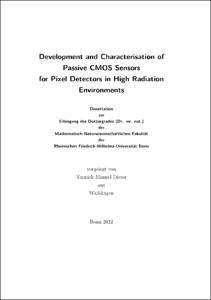Dieter, Yannick Manuel: Development and Characterisation of Passive CMOS Sensors for Pixel Detectors in High Radiation Environments. - Bonn, 2022. - Dissertation, Rheinische Friedrich-Wilhelms-Universität Bonn.
Online-Ausgabe in bonndoc: https://nbn-resolving.org/urn:nbn:de:hbz:5-67787
Online-Ausgabe in bonndoc: https://nbn-resolving.org/urn:nbn:de:hbz:5-67787
@phdthesis{handle:20.500.11811/10346,
urn: https://nbn-resolving.org/urn:nbn:de:hbz:5-67787,
author = {{Yannick Manuel Dieter}},
title = {Development and Characterisation of Passive CMOS Sensors for Pixel Detectors in High Radiation Environments},
school = {Rheinische Friedrich-Wilhelms-Universität Bonn},
year = 2022,
month = oct,
note = {With the upgrade of the Large Hadron Collider (LHC) to the High-Luminosity LHC (HL-LHC), the instantaneous luminosity increases by a factor of five with respect to its design value from 2027. To keep the detectors at the HL-LHC operational in this harsh radiation environment with unprecedented hit rates and radiation levels, they undergo major upgrades. The ATLAS experiment replaces its current tracking detector by a large-area and all-silicon tracking detector consisting of silicon strip and hybrid pixel detectors (ATLAS ITk detector). This challenging upgrade requires the development of radiation tolerant technologies for both the readout electronics and the sensing part of the detector.
In this thesis, the utilisation of a commercial CMOS process line for the production of sensors for hybrid pixel detectors is investigated. CMOS process lines offer high throughput at comparatively low costs and are thus a cost-effective solution for the production of large-area detectors. Further benefits arise from the availability of several features in the used CMOS technology like many metal layers, poly-silicon layers and MIM-capacitors which can help to enhance the sensor design. These features are mostly not available in conventional sensor productions.
After an intensive R&D-programme over several years, large-area passive CMOS sensors compatible with the future readout chip of the ATLAS ITk pixel detector have been successfully manufactured and characterised for the first time. Within the scope of this work, the radiation tolerance (using protons) of passive CMOS sensors up to a fluence of 1e16 neq/cm2 is demonstrated. Furthermore, the performance of passive CMOS sensors before and after irradiation is studied in detail and compared with the sensor requirements for the future ATLAS ITk pixel detector. Crucial parameters like production yield, breakdown behaviour, electronic noise, hit-detection efficiency and charge collection behaviour are investigated. Passive CMOS sensors are found to meet the requirements for the ATLAS ITk pixel detector. In particular, an (in-time) hit-detection efficiency larger than 99% is measured after irradiation demonstrating the suitability of passive CMOS sensors for harsh radiation environments.},
url = {https://hdl.handle.net/20.500.11811/10346}
}
urn: https://nbn-resolving.org/urn:nbn:de:hbz:5-67787,
author = {{Yannick Manuel Dieter}},
title = {Development and Characterisation of Passive CMOS Sensors for Pixel Detectors in High Radiation Environments},
school = {Rheinische Friedrich-Wilhelms-Universität Bonn},
year = 2022,
month = oct,
note = {With the upgrade of the Large Hadron Collider (LHC) to the High-Luminosity LHC (HL-LHC), the instantaneous luminosity increases by a factor of five with respect to its design value from 2027. To keep the detectors at the HL-LHC operational in this harsh radiation environment with unprecedented hit rates and radiation levels, they undergo major upgrades. The ATLAS experiment replaces its current tracking detector by a large-area and all-silicon tracking detector consisting of silicon strip and hybrid pixel detectors (ATLAS ITk detector). This challenging upgrade requires the development of radiation tolerant technologies for both the readout electronics and the sensing part of the detector.
In this thesis, the utilisation of a commercial CMOS process line for the production of sensors for hybrid pixel detectors is investigated. CMOS process lines offer high throughput at comparatively low costs and are thus a cost-effective solution for the production of large-area detectors. Further benefits arise from the availability of several features in the used CMOS technology like many metal layers, poly-silicon layers and MIM-capacitors which can help to enhance the sensor design. These features are mostly not available in conventional sensor productions.
After an intensive R&D-programme over several years, large-area passive CMOS sensors compatible with the future readout chip of the ATLAS ITk pixel detector have been successfully manufactured and characterised for the first time. Within the scope of this work, the radiation tolerance (using protons) of passive CMOS sensors up to a fluence of 1e16 neq/cm2 is demonstrated. Furthermore, the performance of passive CMOS sensors before and after irradiation is studied in detail and compared with the sensor requirements for the future ATLAS ITk pixel detector. Crucial parameters like production yield, breakdown behaviour, electronic noise, hit-detection efficiency and charge collection behaviour are investigated. Passive CMOS sensors are found to meet the requirements for the ATLAS ITk pixel detector. In particular, an (in-time) hit-detection efficiency larger than 99% is measured after irradiation demonstrating the suitability of passive CMOS sensors for harsh radiation environments.},
url = {https://hdl.handle.net/20.500.11811/10346}
}






